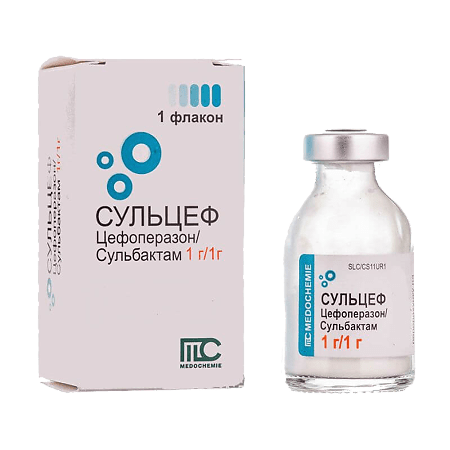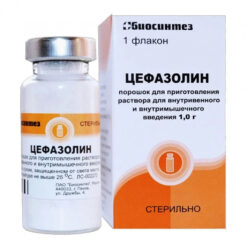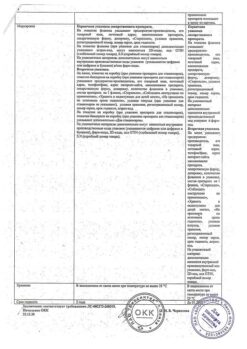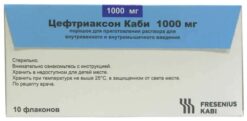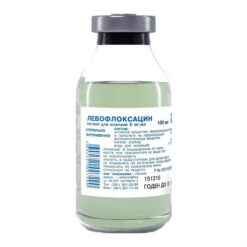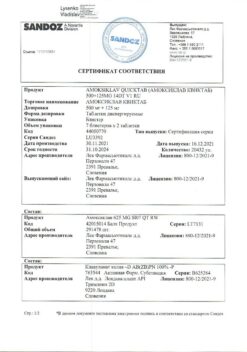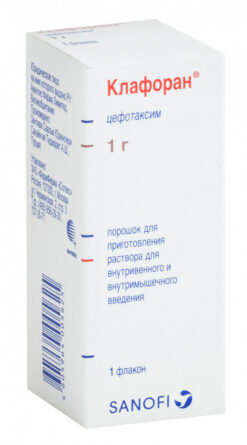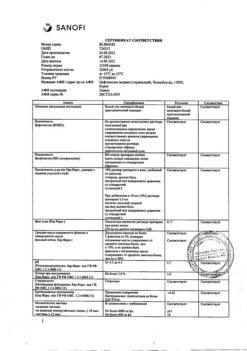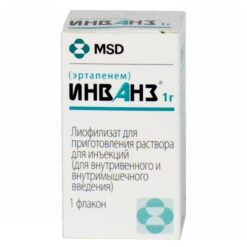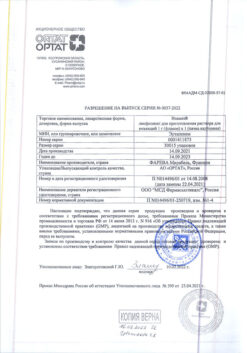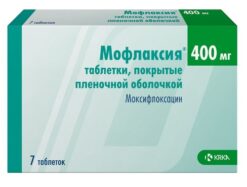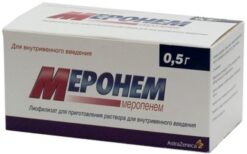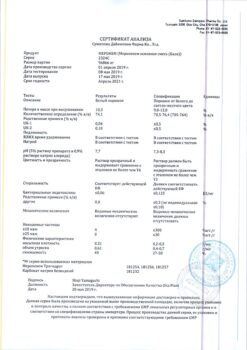No products in the cart.
Sulcef, 1 g+1 g 2.18g
€11364.00 €9.47
Description
Pharmacotherapeutic group : Antibiotic, cephalosporin + beta-lactamase inhibitor.
ATX: J.01.D.D.62
Pharmacodynamics :
Cefoperazone is a third generation cephalosporin that acts on sensitive microorganisms during their active multiplication by inhibiting the biosynthesis of cell wall mucopeptide. Sulbactam has no clinically significant antibacterial activity (except for Neisseriaceae and Acinetobacter) and is an irreversible inhibitor of most major beta-lactamases produced by microorganisms that are resistant to beta-lactam antibiotics. Sulbactam also binds to some penicillin-binding proteins, so the combination of cefoperazone and sulbactam often has a more pronounced effect on sensitive strains than cefoperazone alone
.
The combination of sulbactam and cefoperazone is active against all microorganisms sensitive to cefoperazone. In addition, it is synergistic against various microorganisms, primarily: Haemophilus influenzae, Bacteroides spp., Staphylococcus spp., Acinetobacter calcoaceticus, Enterobacter aerogenes, Escherichia coli, Proteus mirabilis, Klebsiella pneumoniae, Morganella morganii, Citrobacter freundii, Enterobacter cloacae, Citrobacter ersus.
It is active in vitro against a wide range of clinically relevant microorganisms.
Gram-positive microorganisms:
Staphylococcus aureus (producing and not producing penicillinase), Staphylococcus epidermidis, Streptococcus pneumoniae, Streptococcus pyogenes (group A beta-hemolytic streptococcus), Streptococcus agalactiae (group B beta-hemolytic streptococcus), most other strains of beta-hemolytic streptococci, Streptococcus faecalis.
Gram-negative microorganisms:
Klebsiella spp., Enterobacter spp., Citrobacter spp., Proteus vulgaris, Providencia rettgeri, Providencia spp., Serratia spp. (including S. marcescens), Salmonella spp, Shigella spp., Pseudomonas aeruginosa, Neisseria gonorrhoeae, Neisseria meningitidis-, Bordetella pertussis, Yersinia enterocolitica.
Anaerobic microorganisms s Bacteroides fragilis, Fusobacterium spp., Peptococcus spp., Peptostreptococcus spp., Veillonella spp., Clostridium spp., Eubacterium spp., Lactobacillus spp.
Pharmacokinetics:
Cefoperazone and sulbactam are well distributed in various tissues and fluids, including
bile, gallbladder, skin, appendix, fallopian tubes, ovaries, uterus, etc. Maximum concentrations of cefoperazone and sulbactam after intravenous administration of 2 g of the drug for 5 min averaged 130.2 and 236.8 mcg/ml, respectively. The volume of distribution of sulbactam ranged from 18.0 to 27.6 L, cefoperazone from 10.2 to 11.3 L. About 84% of the dose of sulbactam and 25% of the dose of cefoperazone are excreted by the kidneys. The remaining part of cefoperazone is excreted mainly in bile. Half-life of cefoperazone is on average about 1.7 h, sulbactam – 1 h. Serum concentration of cefoperazone and sulbactam is proportional to the administered dose. Pharmacokinetic properties of the drug do not change when repeated administration. No cumulation is observed when the drug is administered every 8-12 hours.
Pharmacokinetics in hepatic dysfunction:
Cefoperazone is actively excreted with bile. Half-life of cefoperazone is usually prolonged and renal excretion of the drug is increased in patients with liver disease and/or biliary obstruction. Even with severe hepatic impairment, therapeutic concentration of cefoperazone is achieved in bile, and the half-life is increased by 2-4 times.
Pharmacokinetics in renal dysfunction:
In patients with various degrees of renal dysfunction receiving the drug, a high correlation between the total clearance of sulbactam from the body and estimated creatinine clearance has been found. In patients with terminal renal failure a significant prolongation of sulbactam elimination half-life was found (on average 6.9-9.7 hours in various studies). Hemodialysis causes significant changes in the elimination half-life, total clearance from the body and the volume of sulbactam distribution.
Pharmacokinetics in the elderly:
In the elderly with renal impairment and impaired liver function, there is an increase in the half-life, decrease in clearance and increased volume of distribution of both sulbactam and cefoperazone. Pharmacokinetics of sulbactam correlates with the degree of impaired renal function, and pharmacokinetics of cefoperazone with the degree of hepatic function.
Pharmacokinetics in children:
In children there are no significant differences in the pharmacokinetics of the drug components compared to adults. The average half-life of sulbactam in children is from 0.91 to 1.42 h, cefoperazone from 1.44 to 1.88 h.
.
Indications
Indications
Infectious and inflammatory diseases caused by microorganisms sensitive to cefoperazone/sulbactam.
– infections of the upper and lower respiratory tract;
– urinary tract infections;
– intra-abdominal infections (peritonitis, cholecystitis, cholangitis);
– septicemia;
– meningitis;
– infections of the skin and soft tissues;
– infections of bones and joints;
– genitourinary tract infections (pelvic inflammatory disease, endometritis, gonorrhea).
Pharmacological effect
Pharmacological effect
Pharmacotherapeutic group:
Antibiotic, cephalosporin + beta-lactamase inhibitor.
ATX: J.01.D.D.62
Pharmacodynamics:
Cefoperazone is a third-generation cephalosporin that acts on sensitive microorganisms during their active reproduction by inhibiting the biosynthesis of cell wall mucopeptide. Sulbactam does not have clinically significant antibacterial activity (with the exception of Neisseriaceae and Acinetobacter), and is an irreversible inhibitor of most major beta-lactamases that produce microorganisms resistant to beta-lactam antibiotics. Sulbactam also binds to some penicillin-binding proteins, so the combination of cefoperazone and sulbactam often has a greater effect on sensitive strains than one alone
cefoperazone.
The combination of sulbactam and cefoperazone is active against all microorganisms sensitive to cefoperazone. In addition, it has synergism against various microorganisms, primarily: Haemophilus influenzae, Bacteroides spp., Staphylococcus spp., Acinetobacter calcoaceticus, Enterobacter aerogenes, Escherichia coli, Proteus mirabilis, Klebsiella pneumoniae, Morganella morganii, Citrobacter freundii, Enterobacter cloacae, Citrobacter ersus.
Active in vitro against a wide range of clinically significant microorganisms.
Gram-positive microorganisms:
Staphylococcus aureus (penicillinase-producing and non-penicillinase-producing), Staphylococcus epidermidis, Streptococcus pneumoniae, Streptococcus pyogenes (group A beta-hemolytic streptococcus), Streptococcus agalactiae (group B beta-hemolytic streptococcus), most other strains of beta-hemolytic streptococci, Streptococcus faecalis.
Gram-negative microorganisms:
Klebsiella spp., Enterobacter spp., Citrobacter spp., Proteus vulgaris, Providencia rettgeri, Providencia spp., Serratia spp. (including S. marcescens), Salmonella spp., Shigella spp., Pseudomonas aeruginosa, Neisseria gonorrhoeae, Neisseria meningitidis-, Bordetella pertussis, Yersinia enterocolitica.
Anaerobic microorganisms Bacteroides fragilis, Fusobacterium spp., Peptococcus spp., Peptostreptococcus spp., Veillonella spp., Clostridium spp., Eubacterium spp., Lactobacillus spp.
Pharmacokinetics:
Cefoperazone and sulbactam are well distributed into various tissues and fluids, including
bile, gall bladder, skin, appendix, fallopian tubes, ovaries, uterus, etc. The maximum concentrations of cefoperazone and sulbactam after intravenous administration of 2 g of the drug over 5 minutes average 130.2 and 236.8 μg/ml, respectively. The volume of distribution of sulbactam is from 18.0 to 27.6 l, cefoperazone – from 10.2 to 11.3 l. About 84% of a dose of sulbactam and 25% of a dose of cefoperazone are excreted by the kidneys. The remaining part of cefoperazone is excreted mainly by bile. The half-life of cefoperazone averages about 1.7 hours, sulbactam – 1 hour. The serum concentration of cefoperazone and sulbactam is proportional to the administered dose. With repeated administration, the pharmacokinetic properties of the drug do not change. When the drug is administered every 8-12 hours, no accumulation is observed.
Pharmacokinetics for liver dysfunction:
Cefoperazone is actively excreted in bile. The half-life of cefoperazone is usually prolonged and renal excretion of the drug is increased in patients with liver disease and/or biliary tract obstruction. Even with severe liver dysfunction, a therapeutic concentration of cefoperazone is achieved in the bile, and the half-life increases by 2-4 times.
Pharmacokinetics for renal impairment:
In patients with varying degrees of renal impairment receiving the drug, a high correlation was found between the total clearance of sulbactam from the body and the calculated creatinine clearance. In patients with end-stage renal failure, a significant prolongation of the half-life of sulbactam was detected (on average 6.9-9.7 hours in various studies). Hemodialysis causes significant changes in the half-life, total body clearance, and volume of distribution of sulbactam.
Pharmacokinetics in the elderly:
In elderly people with renal failure and impaired liver function, there is an increase in the half-life, decreased clearance and increased volume of distribution of both sulbactam and cefoperazone. The pharmacokinetics of sulbactam correlates with the degree of renal dysfunction, and the pharmacokinetics of cefoperazone correlates with the degree of liver dysfunction.
Pharmacokinetics in children:
In children there are no significant differences in the pharmacokinetics of the drug components compared to adults. The average half-life of sulbactam in children is from 0.91 to 1.42 hours, cefoperazone – from 1.44 to 1.88 hours.
Special instructions
Special instructions
If allergic reactions occur, it is necessary to discontinue the drug and prescribe adequate therapy. When treated with cefoperazone, in rare cases, vitamin K deficiency develops. The reason for this is probably the suppression of the normal intestinal microflora, which synthesizes this vitamin. The risk group includes patients who receive poor nutrition, suffer from malabsorption (for example, with cystic fibrosis) and are on intravenous artificial nutrition for a long time.
In such cases, as well as in patients receiving anticoagulants, it is necessary to monitor the prothrombin time and, if indicated, prescribe vitamin K. With long-term treatment, excessive growth of insensitive microorganisms is possible. Patients must be carefully monitored during treatment. During long-term therapy, it is recommended to periodically monitor indicators of the function of internal organs, including the kidneys, liver and hematopoietic system. This is especially important when treating newborns, especially premature babies, and small children.
When using aminoglycosides concomitantly, it is necessary to monitor renal function. In case of severe obstruction of the biliary tract, severe liver failure, it is necessary to change the dose and control the concentration of cefoperazone in the serum (maximum daily dose – 2 g). Treatment of premature newborns is carried out if the possible benefit outweighs the potential risk.
Effect on laboratory test results. When using Benedict’s or Fehling’s solution, a false-positive reaction to glucose in the urine may occur. A false positive Coombs test is possible.
Effect on ability to drive:
The drug does not affect the ability to drive vehicles and maintain machinery.
Active ingredient
Active ingredient
Cefoperazone, Sulbactam
Composition
Composition
1 bottle contains active substances:
Cefoperazone sodium equivalent to 1.0 g cefoperazone
Sodium sulbactam equivalent to 1.0 g sulbactam
Pregnancy
Pregnancy
During pregnancy and breastfeeding, the drug is used only if the expected benefit to the mother outweighs the potential risk to the fetus and newborn.
Contraindications
Contraindications
Hypersensitivity to penicillins, sulbactam, cefoperazone, incl. to other beta-lactam antibiotics.
With caution:
Severe renal and liver dysfunction, colitis (including history), premature newborns.
Side Effects
Side Effects
Cardiovascular system: decreased blood pressure.
Gastrointestinal tract: diarrhea, nausea, vomiting, pseudomembranous colitis.
Allergic reactions: maculopapular rash, urticaria, itching, Stevens-Johnson syndrome, anaphylactic shock. The risk of reactions is higher in patients with a history of allergic reactions.
Hematopoietic system: decreased number of neutrophils. With long-term treatment, reversible neutropenia develops, a decrease in hemoglobin and hematocrit, transient eosinophilia, leukopenia, thrombocytopenia, as well as hypoprothrombinemia, hypercreatininemia, anemia, and bleeding are noted.
Laboratory indicators: increased activity of “liver” transaminases – aspartate aminotransferase (ACT), alanine aminotransferase (AJ1T), alkaline phosphatase, bilirubin in blood serum, hematuria. In some patients, a false-positive Coombs test was observed during treatment.
Local reactions: after intramuscular injection, transient pain is possible. When administering the drug intravenously using a catheter, phlebitis may develop at the infusion site.
Others: headache, fever, chills, vasculitis.
Interaction
Interaction
Ethanol When drinking alcohol during treatment with the drug and for the next 5 days after its administration, disulfiram-like reactions, characterized by hot flashes, sweating, headache and tachycardia, have been reported, so patients should be warned about the possibility of their occurrence when consuming alcoholic beverages during treatment with the drug.
In patients who require artificial nutrition (orally or parenterally), the use of solutions containing
ethanol
Aminoglycosides
Solutions of the drug and aminoglycosides should not be mixed, given the pharmaceutical incompatibility between them. If combination therapy with a drug and an aminoglycoside is given, the two drugs are administered by sequential infusions using separate secondary catheters, and the primary catheter is flushed with adequate solution between drug doses. The intervals between the administration of the drug and the aminoglycoside during the day should be as long as possible.
Loop diuretics
Concomitant use of the drug with loop diuretics can lead to the development of nephrotoxicity.
Compatible with water for injection, 5% dextrose solution, 0.9% sodium chloride solution, 5% dextrose solution in 0.225% sodium chloride solution, 5% dextrose solution in 0.9% sodium chloride solution.
Incompatible with Ringer’s solution, 2% lidocaine solution (initial use of water for injection results in a compatible mixture).
Overdose
Overdose
Symptoms: neurological disorders, including seizures.
Treatment: sedative therapy. Hemodialysis is effective, especially in patients with impaired renal function.
Storage conditions
Storage conditions
The drug should be stored out of the reach of children, protected from light at a temperature not exceeding 25°C.
Shelf life
Shelf life
2 years. Do not use after the expiration date stated on the package.
Manufacturer
Manufacturer
Medokemi Ltd, Cyprus
Additional information
| Shelf life | 2 years. Do not use after the expiration date stated on the package. |
|---|---|
| Conditions of storage | The drug should be kept out of reach of children, protected from light at a temperature not exceeding 25°C. |
| Manufacturer | Medokemi Ltd, Cyprus |
| Medication form | Powder for preparation of solution |
| Brand | Medokemi Ltd |
Related products
Buy Sulcef, 1 g+1 g 2.18g with delivery to USA, UK, Europe and over 120 other countries.

